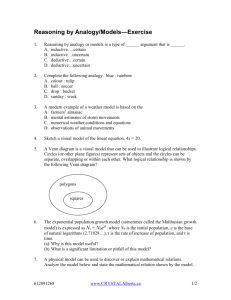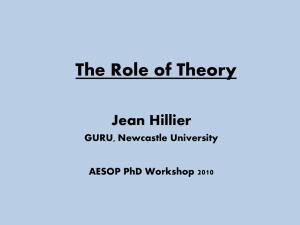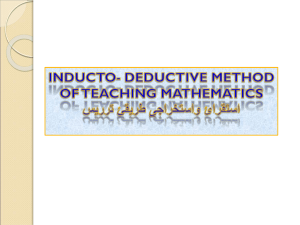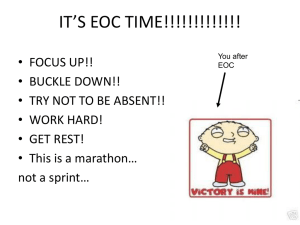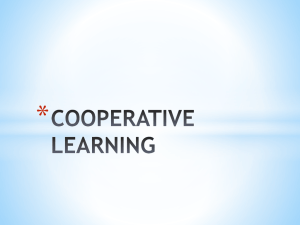INDUCTIVE AND DEDUCTIVE METHODOLOGY
advertisement
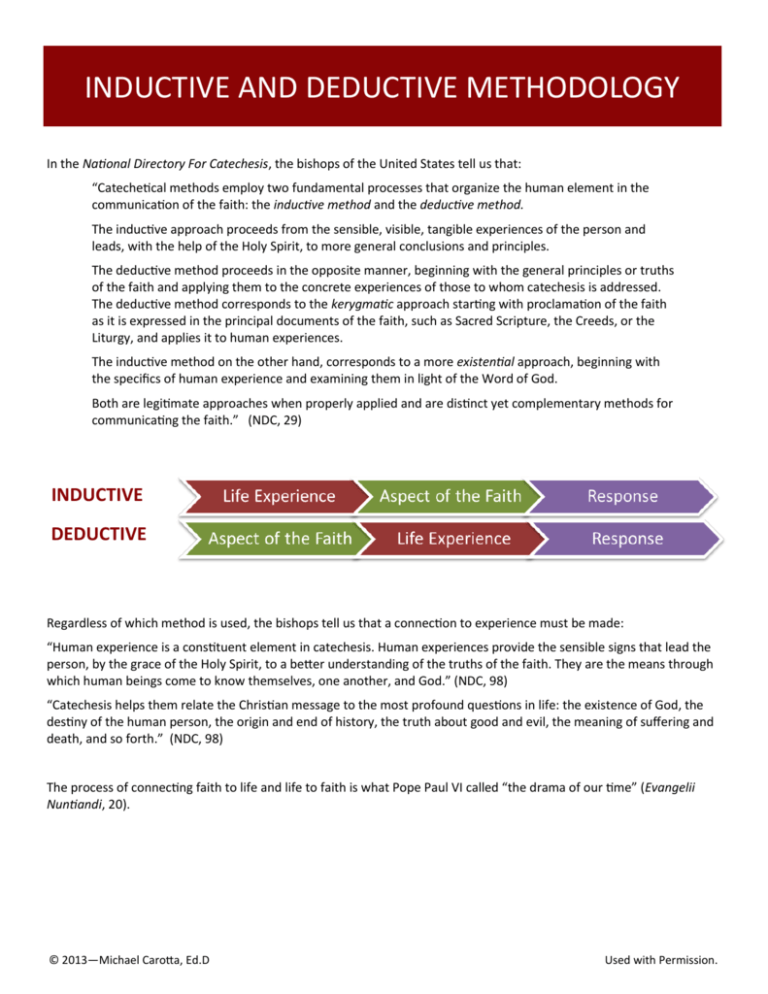
INDUCTIVE AND DEDUCTIVE METHODOLOGY In the National Directory For Catechesis, the bishops of the United States tell us that: “Catechetical methods employ two fundamental processes that organize the human element in the communication of the faith: the inductive method and the deductive method. The inductive approach proceeds from the sensible, visible, tangible experiences of the person and leads, with the help of the Holy Spirit, to more general conclusions and principles. The deductive method proceeds in the opposite manner, beginning with the general principles or truths of the faith and applying them to the concrete experiences of those to whom catechesis is addressed. The deductive method corresponds to the kerygmatic approach starting with proclamation of the faith as it is expressed in the principal documents of the faith, such as Sacred Scripture, the Creeds, or the Liturgy, and applies it to human experiences. The inductive method on the other hand, corresponds to a more existential approach, beginning with the specifics of human experience and examining them in light of the Word of God. Both are legitimate approaches when properly applied and are distinct yet complementary methods for communicating the faith.” (NDC, 29) INDUCTIVE DEDUCTIVE Regardless of which method is used, the bishops tell us that a connection to experience must be made: “Human experience is a constituent element in catechesis. Human experiences provide the sensible signs that lead the person, by the grace of the Holy Spirit, to a better understanding of the truths of the faith. They are the means through which human beings come to know themselves, one another, and God.” (NDC, 98) “Catechesis helps them relate the Christian message to the most profound questions in life: the existence of God, the destiny of the human person, the origin and end of history, the truth about good and evil, the meaning of suffering and death, and so forth.” (NDC, 98) The process of connecting faith to life and life to faith is what Pope Paul VI called “the drama of our time” (Evangelii Nuntiandi, 20). © 2013—Michael Carotta, Ed.D Used with Permission. Note: Current Confirmation programs and resources are full of solid sessions. The two examples that follow are offered as simple illustrations through which we can compare inductive and deductive methodology. Example 1: Responsibility for Advocacy (Challenging moral/theological reflection) An inductive approach: 1. Life Experience The catechist could share a newspaper story or a current event in which a person or group is displaying “righteous anger” as a form of advocacy for injustice. OR Candidates would be asked—privately or in groups—to describe a time they were angry over something they felt was unjust or when they saw someone being taken advantaged of and how they responded to that situation. 2. Faith Content The scripture passage of Jesus and The Money Changers In the Temple would be studied followed by some information that would clarify the reason their presence in the temple was infuriating back in Jesus’ day. Supplemental discussion questions might include: Who or what reminds you of money changers in our society today? (unfair lenders/mortgage companies, health insurance companies, frauds taking advantage of the elderly, anonymous internet rumor mongers, etc.) What might Jesus suggest as an appropriate way to respond? What would Advocacy look like in this situation? How can someone be guilty of unjust Advocacy? 3. Response Ask the group to privately assess: “Give your self a grade regarding your overall tendency to engage in Advocacy and list two political or personal situations to which you are willing to pay more attention.” A deductive approach would invert the order of the first two steps and look like this: 1. Faith Content Start with the scripture passage of Jesus and the money changers In the temple followed by information that would clarify the reason the presence of these people in the temple was infuriating back in Jesus’ day. 2. Life Experience Everyone would then be asked—privately or in groups—to describe a time they were angry over something they felt was unjust or when they saw someone being taken advantaged of. OR Share a newspaper story or a current event in which a person or group is displaying “righteous anger” as a form of advocacy for injustice—much like Jesus did in the scripture passage. Supplemental discussion questions might include: Who or what reminds you of money changers in our society today? (unfair lenders/mortgage companies, health insurance companies, frauds taking advantage of the elderly, anonymous internet rumor mongers, etc.) What might Jesus suggest as an appropriate way to respond? What would Advocacy look like in this situation? How can someone be guilty of unjust Advocacy? 3. Response Ask the group to privately assess: “Give your self a grade regarding your overall tendency to engage in Advocacy and list two political or personal situations to which you are willing to pay more attention.” © 2013—Michael Carotta, Ed.D Used with Permission. Example 2: Recognizing God’s Presence (Spiritual sensitivity/awakenings) An inductive approach: 1. Life Experience Everyone reads the following quotes and discuss their answers in triads: A college student studying biology says, “studying the human birth process convinced me that there was a God. I mean, look at the way the human body was designed to produce more humans. The mother’s body like automatically stops producing some regular stuff and ‘automatically‘ starts producing some new stuff just so she can nurture the baby. A whole like organized and complicated new process kicks in just to produce the baby. Afterwards the process just automatically stops. Perfectly designed. Had to be invented by someone like God. Couldn’t have been designed by accident—or like by itself.” A soldier in Iraq says: “War is about killing. Period. It’s hell. Literally. Guys brutally trying to kill each and maim each other. Ruthless. It’s the last place on earth that you’d expect to see God. But there is something really powerful, I’m gonna say, holy, really, when you see someone sacrifice his or her life for another person- or sacrifice their life for the people of their country. On both sides. Whenever I saw it, I felt like I saw true love. Am I making any sense?” Breaking news interrupts the TV show to report the devastation of a massive earthquake in China killing 50,000 people. After hearing the report , a high school sophomore stands up and heads to the fridge saying : “I don’t get it. how can God that’s supposed to be so loving and all bring this on like 50,000 innocent people?” Pick one of these statements and explain why you agree or disagree with it, and then offer another example to go along with the one you’ve picked. 2. Faith Content Through print, PowerPoint presentation, a textbook, or a handout young people are introduced to content regarding ways of coming to know God (truth, beauty, love) as found in the Catechism of the Catholic Church #31-36. The catechist takes them through this information, giving examples of each and checking for understanding along the way. 3. Response Privately, or as a group, everyone responds to these kinds of questions: When have you felt closest to God in the last six months? Was it during a certain activity, with a certain person or group, or in a certain place? Which. Write about a time when you recognized the Presence of God in a moment of Truth, Beauty, or Love. See if you can name a time for each of the three. What are the exact opposites of Truth, Beauty, Love? Can a person recognize the Presence of God in these times too? Explain your answer. © 2013—Michael Carotta, Ed.D Used with Permission. A deductive approach might simply change the order of the process along with a few discussion questions: 1. Faith Content Through print, PowerPoint presentation, a textbook, or a handout young people are introduced to content regarding ways of coming to know God (truth, beauty, love) as found in the Catechism of the Catholic Church #31-36. The catechist takes them through this information, giving examples of each and checking for understanding along the way. 2. Life Experience: Everyone reads the following quotes and discuss their answers in triads: A college student studying biology says, “studying the human birth process convinced me that there was a God. I mean, look at the way the human body was designed to produce more humans. The mother’s body like automatically stops producing some regular stuff and ‘automatically‘ starts producing some new stuff just so she can nurture the baby. A whole like organized and complicated new process kicks in just to produce the baby. Afterwards the process just automatically stops. Perfectly designed. Had to be invented by someone like God. Couldn’t have been designed by accident—or like by itself.” A soldier in Iraq says: “War is about killing. Period. It’s hell. Literally. Guys brutally trying to kill each and maim each other. Ruthless. It’s the last place on earth that you’d expect to see God. But there is something really powerful, I’m gonna say, holy, really, when you see someone sacrifice his or her life for another person- or sacrifice their life for the people of their country. On both sides. Whenever I saw it, I felt like I saw true love. Am I making any sense?” Breaking news interrupts the TV show to report the devastation of a massive earthquake in China killing 50,000 people. After hearing the report , a high school sophomore stands up and heads to the fridge saying: “I don’t get it. how can God that’s supposed to be so loving and all bring this on like 50,000 innocent people?” Pick one of these statements and explain why you agree or disagree with it, and then offer another example to go along with the one you’ve picked. 3. Response: Privately, or as a group, everyone responds to these kinds of questions: When have you felt closest to God in the last six months? Was it during a certain activity, with a certain person or group, or in a certain place? Which. Write about a time when you recognized the Presence of God in a moment of Truth, Beauty, or Love. See if you can name a time for each of the three. What are the exact opposites of Truth, Beauty, Love? Can a person recognize the Presence of God in these times too? Explain your answer. Note: If you have a 60 minute session with candidates: You could divide the session into 3 different topics and use the inductive method with some topic(s) and the deductive method with some topic(s). If you spent only 15 minutes on each topic, you could use the remaining 15 minutes in the session for a closing prayer experience related to the three topics covered in the session. Covering several topics in a session often keeps the pace moving and keeps interest from waning. Prayer- done well - can touch some candidates in ways that inductive and deductive methods do not- especially at night- with music, a candle, and bibles. OR You could cover one topic by spreading the three components of an inductive or deductive method over 60 minutes. But you are free to spend more time on one component than the others. You may for example spend 20 minutes on one component, 30 minutes on another component, and 10 minutes on another component. © 2013—Michael Carotta, Ed.D Used with Permission. SO… When you look for confirmation prep resources: Keep an eye out for the how often they employ these two different methods See if it enables you to fit several topics into one session- using different techniques Determine if the specific questions, activities, and information best addresses the enhancement you want to address—and is within the comprehension level of your candidates © 2013—Michael Carotta, Ed.D Used with Permission.
